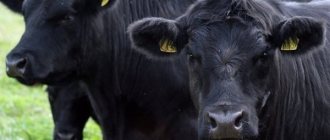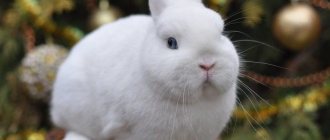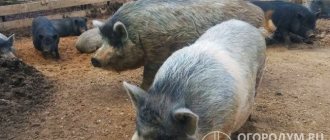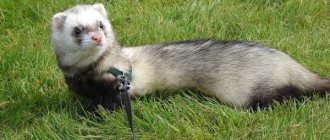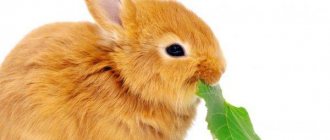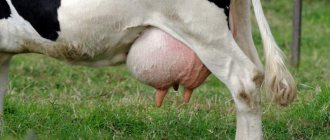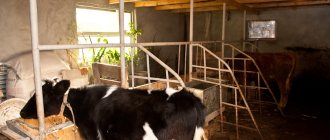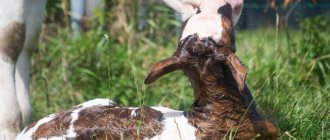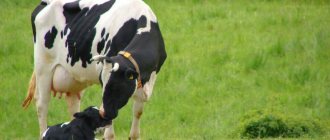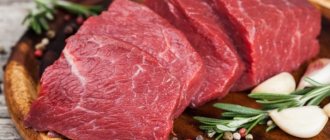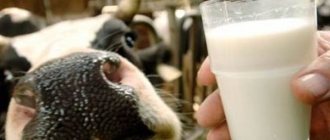A well-built animal farm is the dream of any professional breeder. The health of the livestock directly depends on how comfortable the conditions are. The requirements for the improvement of buildings are quite high, but this fact is compensated by the fact that with proper care, the overall productivity of livestock increases, and a person makes a profit. This article will describe what types of buildings there are for cows, outline the types of structures being built and the features of the materials for their manufacture.
The best breeds for personal farming
There are two types of cows: dairy and beef. Let's consider the best breeds of cows for breeding on a private farm.
Dairy cows:
- Holstein;
- Jersey;
- Simmental;
- Yaroslavl
Meat breeds of cows:
- Hereford;
- Belgian blue;
- Kian;
- Auliekolskaya.
Depending on what the owner needs to receive more: milk or meat, he has a choice in purchasing a cow suitable for him.
Cow breeding
Planning inseminations
Among livestock breeders and researchers, disputes often arise about the advisability of annual insemination of cows. Proponents of breaks in insemination say that annual pregnancy and childbirth have a harmful effect on the body of cows, leading to rapid wear and tear and culling.
They also point out that the amount of milk produced by a cow reaches its maximum only in the third and fourth lactation. Thus, early wear and tear of cows leads to losses of possible milk yield. Perhaps this approach has a right to exist, but only within the framework of small peasant farms. It is with this kind of farming that the inevitable decrease in milk yield of cows that give birth every 2-3 years is a completely acceptable price for a significant increase in the life expectancy of the animal.
In large productions designed for the use of high-milk cows, it is more profitable to inseminate annually.
Age and live weight of cows for fruitful insemination
Cows are allowed for breeding at the age of 16–18 months, and representatives of late-ripening breeds at 20–22 months.
By the time of the first mating, the weight of the cow should be at least 70% of the average weight of an adult animal of the corresponding breed.
For breeding bulls, the age of onset of use is slightly higher. Producers of meat breeds can begin to be used as early as 15 months of age, but gaining optimal weight is mandatory for them as well.
In the first year of use, stud bulls are given a moderate load - no more than 1-2 cages per day.
Since ancient times, the breeding of cows has been under the control of the owners. Free mating, when cows and adult bulls are kept together in a herd, was used only at the beginning of keeping these animals. Currently, large farms mainly use artificial insemination, which makes it possible to obtain a large number of offspring from one bull. The creation of a sperm bank from high-breed sires makes it possible to use their outstanding qualities even after the death of the animal.
In small peasant farms, the method of manual mating is still used, when the bull is brought to a certain cow, and she is fixed in a special machine or tied.
The gestation period of cows is 9 months. One, much less often, two calves are born. In private farms, the calf is left with its mother until it reaches six months of age. All this time he is fed with mother's milk. There is a method of raising calves with a nurse cow, to which 2 to 4 heads of young animals are assigned. This method of cultivation is used in small farms focused on dairy production.
For the role of wet nurses, low-milk cows or individuals with non-standard teats or udders are used if the farm uses a machine milking method.
In large dairy farms that intensively use high-milk cows, calves are raised separately from their mothers and are often transferred to artificial feeding from the first days of life. This approach leads to the emergence of mass diseases in calves, deprived of the opportunity to obtain immune bodies from mother's milk.
Types of keeping cows on private farms
Several types of cow housing are suitable for personal keeping of cows.
Pasture
This type of housing is suitable only for individuals that were sent for fattening and for raising young animals. The same thing happens in large agricultural farms. In this case, the cows spend the entire walking period on pasture in special camps. Milking takes place in special milking parlors right next to the pasture. This is beneficial for private animal keeping.
Stall
In this case, there is no walking for animals; they live in stalls. This type of maintenance is used extremely rarely and only if there is no land for pasture. The cows eat the delivered prepared food directly in the stall, and walk in designated areas for about 3 hours a day. This method is not suitable for personal farming, since feeding imported food all year round is expensive. This method is used only in the winter season, when pasture walking is impossible.
Pyvyaznoe
This method is used in large farms, but there are some positive aspects of tethered housing in the household:
- If several animals are kept in one barn, it becomes possible to tie each cow to a leash. This is necessary to avoid injury to weaker livestock.
- Cleaning up recycled waste will be easier since you only have to clean up the back and not the entire stall.
- A tether is used for treatment or artificial insemination.
- It is easier to monitor the condition of the animal and the amount of food eaten; thanks to this method, it is possible to find out the disease, if any, at the initial stages.
- Easy care for cows, namely udder treatment, hoof cleaning, milking and other manipulations.
- An individual approach to each animal is provided: feeding, feeding.
- The animal quickly gets used to its owner, since it is in close contact with him.
In addition to the positive aspects, there are also negative ones:
- Prolonged sitting on a leash can lead to problems with the musculoskeletal system.
- Feeding and watering animals is somewhat difficult.
- Keeping a cow tied for a long time can lead to retained placenta. In other words, after the birth of a calf, the placenta is attached to the walls of the uterus, and it can only be removed by surgery.
- It is impossible to keep a cow on a leash before giving birth, as this can lead to injury to the baby.
Untied
Free-stall housing is also used in both large and household households. This type of content is popular due to its convenience and low cost. The litter is changed twice a year, and straw or sawdust is added as the top layer gets wet.
Thus, the lower layers of the litter find themselves without oxygen, being exposed to biochemical effects. As a result, strong heat is released from under the lower layer, which serves as heating especially in winter.
The feed is poured into a common large feeder, which simplifies the work with the help of equipment. Often, whole bales of hay are laid out in the yard, from which the animals feed. There is only one drawback - the amount of feed increases. The advantage is that you can simultaneously place several heads in a certain area.
In the boxes
Cows are kept in special box sections. The animals are constantly in the box, and only sometimes move to the opposite side to feed. Thanks to the equipment of cows in boxes, they can be milked, cared for and given rest. In one section there are approximately 40 heads, which are distributed by age.
Such maintenance saves space and facilitates the entire process of caring for the animal, because everything happens at a mechanized level. This has a positive effect on milk production.
What it is?
Animals will bring considerable income , since milk can be used to make butter, cheese and other fermented milk products, freeze meat, sell it fresh, or seal a stew. Another option for generating income is raising and reselling young animals. The first step of a novice farmer is a thorough analysis of the slightest nuances of the future business.
Before understanding how to breed cows, it is necessary to understand the ultimate goals of this action.
- Analysis of the conditions of the region of residence (are there fields for grazing).
- Economic factor (competitors and product market).
- Features of keeping cows in winter and summer.
- Clarification of the final goal (obtaining meat, milk or complex products). Selection of appropriate breeds.
- Environmental factor (where to sell manure).
Cows are distinguished by their large size, good appetite (they consume a lot of feed) and demanding conditions in their place of residence, but all these aspects are quickly covered by finished products.
Arrangement of the barn
If you have decided to get yourself a cow, then it is necessary to have a barn where the animal will spend nights and days in winter. Making your own shed is quite simple, and any material will do:
- tree;
- brick;
- plate.
But you should take into account the climate in which the animal will live; for example, in northern latitudes, the barn needs to be additionally insulated. The temperature in the barn should not be below 10 degrees for the cows to feel comfortable. The floor must be wooden with a mandatory slope from the drinking bowl to the manure pit to allow excess liquid to leak out.
There should be 5-6 square meters per head, and if the cow is with a calf, then the area should be increased to 10 square meters. The room should be light and have ventilation cooling. The calf cage should be spacious, light, warm and clean.
For greater comfort, a bedding is laid on the floor, which is changed every day. Feeders and drinkers should be installed at muzzle level so that cows have constant access to them. If there are individuals of different ages in the same room, it is necessary to install a grill between them to avoid injury.
There should be only one door to enter the barn to prevent drafts. The entire room, drinking bowls and feeders must be cleaned and washed daily so that the animals do not become infected with helminths and other diseases. Once every three months, the premises are disinfected to exclude various diseases.
In the video, the owner of the cow explains how best to set up a barn, how much milk cows produce on a private farm, and when and how they graze:
Choosing a foundation
The foundation is considered the most important element for any typical structure. Ribbon, monolithic and columnar types are offered to farmers. The choice should be made based on the size of the constructed building.
For example, a small wooden shed can withstand even a budget pillar type of reinforcing surface, while a monolithic or strip foundation is suitable for a brick structure.
In the overwhelming majority of cases, a large barn is built by professional breeders, since in such a room it is quite problematic to regulate the lighting and a comfortable microclimate for animals.
In the process of laying the foundation, attention should be paid to the fact that the barn must be equipped with liquid collectors, into which the animal’s urine and manure will flow. The lower side of the slope of the structure should be at least 15 cm, and the optimal width can reach 30 cm.
Regardless of the size of a typical building, slurry with waste is changed at least once every 25-30 days.
Inventory
After completing the construction of the barn, it is necessary to take care of the feed room. They cannot be stored in the barn itself, as they will become saturated with manure and begin to quickly deteriorate.
In addition, you should take care of the necessary equipment that the owner will work with:
- scales;
- buckets;
- shovel (scraper and shovel);
- pitchfork;
- rake;
- feeders;
- drinking bowls;
- containers for storing feed;
- brushes for cleaning cows;
- clothing and footwear specifically designated for the barn.
Stey for bulls
The building for keeping bull calves is practically no different from a conventional barn in design. But, since the weight of adult animals is quite large, key attention should be paid to gender.
It should be located above ground level so that during the cold season or during rains cold air and moisture do not penetrate into the room. In addition, the floor must be insulated, and it is better to build it from materials that can be conveniently cleaned of manure in the future.
Note: The floor in the bull barn should have a slight slope towards the slurry collection tank.
As a rule, plank flooring based on concrete or cement screed is used as flooring in a steer shed. This floor can withstand the weight of animals well and has a long service life.
From the video you will learn how to build and equip a barn for summer and winter housing of livestock.
Care and hygiene
Compliance with proper standards of caring for livestock directly affects their productivity. The weight of one cow is 500 kg, but they are herd animals, so it would be advisable to have several individuals in the household. If this is not possible, then it is recommended to graze with other animals so that the young animals develop properly.
In summer, animals should not be kept indoors; they should be allowed to walk all the time. It is necessary to make a canopy on the walking area where the cows can hide from the sun and rain. A pack of salt and a drinking bowl should also be placed there, where there should always be clean water.
Milking is one of the main processes in private farming. This should happen three times a day using your hands. Before starting, you need to carefully inspect the milking and udder for damage, after which it should be massaged. Milking must be completed until the udder is empty and soft to the very last drop.
Summer care
To obtain high productivity indicators, it is necessary to observe certain breaks between feeding, milking and even cleaning. In the morning from 5 to 6 o'clock they feed and clean the barn, the same manipulations are carried out at 13 o'clock and in the interval from 20 to 21 o'clock. In addition, the schedule should also be followed when distributing feed and taking the heads out for walking.
In the summer, cow's milk is of the highest quality, since the grass that cows chew on pastures is very healthy. In addition, this is a good saving on animal nutrition.
Winter care
Caring for an animal in the winter includes preparing for housing and equipment.
- If there are cracks, they must be sealed, and the windows, floor and ceiling must be insulated.
- Equipment is disinfected and checked for damage.
- Windows should be such that they can be easily opened for ventilation; they should be located behind the animal, to the side or above the head.
It is important to change the litter in a timely manner. It can be made from straw, which needs 2.5 kg per head. You can also use peat, which has hygroscopic properties, or spruce branches, sawdust, they are also capable of absorbing moisture.
Using adobe
Almost any animal farm is equipped with structures partially made of adobe. This fact is explained by the fact that this material is inexpensive and at the same time has high wear resistance.
In addition, adobe is made from environmentally friendly raw materials and perfectly retains heat in rooms. It is for this reason that with the help of this material you can create a truly homely atmosphere for a cow. Animals in such a structure will feel good and will not freeze in winter.
In areas where cows live, adobe floors can also be installed. The only disadvantage of this solution is that cleaning the cow’s habitat will be quite problematic. But such a floor will not lead to frostbite of the animal and will withstand high mechanical pressure.
Walk
If the cows are kept free-stall, then walking should take place daily. Walking independently in the pasture, cows feed naturally, consuming healthy, succulent feed. Fresh grass is full of vitamins and other beneficial substances that are necessary for proper growth.
Free-stall housing is carried out in late autumn and early spring. If walking takes place on artificial pastures, then they should be tied 5 meters from the peg, which should change its location from time to time.
Conditions of detention
In order for a cow to live as long as representatives of its species should, the appropriate conditions of detention must be observed:
- Free access to water at any time;
- The location should not be ventilated;
- It is necessary to clean the premises daily of waste, including food waste, so that the cow is kept clean. Otherwise, it will be difficult to milk an animal in the mud;
- An adult cow needs approximately 20 kg of hay daily. The diet should also include fresh grass or vegetables, bran, and silage. The animal must receive its portion of salt daily. Place a small block in the feeder and she will lick it herself if she needs to. If the nutrition is normal, she can gain up to 500 kg of weight. The cow is fed twice a day;
- The barn must be disinfected periodically to eliminate all diseases;
- In the summer, she must “walk” in the pasture. In winter, this option is also acceptable, but if the temperature is too low, it is excluded. During the summer grazing period, the animal is almost completely transferred to pasture;
- The same amount of time should pass between feeding and milking.
Pregnancy and calving of cows
The duration of a cow's pregnancy is, like that of humans, 9 months; 2 months before the expected date of birth, the animal should stop milking. This is done to ensure that the calf is born healthy and strong. In addition, succulent feed is removed from the diet of a pregnant cow within a month and a half, and the amount of concentrated feed is reduced.
Hay and special vitamin supplements must be included in the diet of a pregnant cow; they will be beneficial to both the calf and its mother. A couple of weeks before giving birth, the cow will change her behavior. She moves away from other animals, lags behind them on the walk and begins to build a nest, pulling the bedding into a lump. This does not mean that the cow should be kept in a barn; walking is still necessary.
Just before giving birth, the cow is transferred to a separate room; the harbingers of childbirth are a drooping abdomen and a swollen udder. It must be disinfected, covered with hay and burlap. Light calving takes no more than 30 minutes. Immediately after birth, the calf should be wiped with a clean cloth, mucus should be cleared from the nose, ears and eyes, and the umbilical cord should be cut with sterile scissors.
How much can you earn from one cow?
In Russia, a liter of such farm product costs on average about 53 rubles. That is, from one cow
in a year you can get approximately 318,000 rubles.
If 38,000 rubles are spent on maintenance, the income will thus be 0 = 280,000 rubles. from one cow
.
Interesting materials:
What are the leaves or flowers of Ivan tea brewed? What does it mean if a rose's leaves curl? What does the yellow border on cucumber leaves mean? Why do trees shed leaves? What are nut leaves used for? Why do you need a checklist in painting by numbers? Why do the leaves fall? What are oak leaves useful for? How to deal with rust on pear leaves? How to deal with rust on currant leaves?
How are calves kept?
The first days after birth are very important; during this period the calf is exposed to bad environmental influences. The room in which the calf will be located must be warm and draft free. 2 hours after birth, the baby should drink a portion of colostrum, which is necessary for the proper development and growth of the calf. On the second day, he can already be given breast milk. Read more about feeding calves from birth here.
During the first month, the calf will drink milk and additionally receive succulent concentrated feed. Then, over the course of a month, the amount of milk is reduced, and the amount of solid food, on the contrary, is increased.
Calves are kept separately from their mothers in a special walking area, where hay, succulent feed and always water are always available. If there are several babies, then from the age of 8 months they are divided by gender. Already at the age of one and a half years, the heifer is ready for pregnancy, but provided that her weight is 70% of an adult.
Walls
When constructing a standard structure for housing cattle, it is necessary to pay close attention to the choice of material from which the walls will be made. To create comfortable conditions, the following types of raw materials are most often used:
- brick;
- foam blocks;
- adobe;
- metal;
- tree.
The wayward cow does not tolerate the cold, so the room must be warm even on the harshest winter day. As with the choice of flooring, the breeder is advised to study the positive and negative sides of all types of building materials, and only then make a decision.
For small farms, a wooden barn is an ideal option. The structures are quickly constructed and, when individual parts of a small-sized wall wear out, they are easy to replace. Wood retains heat well, is resistant to moisture and does not emit harmful substances into the environment.
The walls in the building where cows live year-round can be made of brick. This material is suitable for use in large structures, as it is highly wear-resistant and does not absorb moisture. The only disadvantage of this choice is that such structures will have to be additionally insulated with glass wool.
The issue of using barns made of metal structures is quite controversial. The material, of course, is highly resistant to wind and moisture, but it does not retain heat inside the room at all. Such structures will need to be insulated on all sides, which will be very expensive.
Foam block walls are an ideal option for cow buildings. The given building material retains heat well, so additional insulation is not required. The only, but significant, disadvantage is that the design is not resistant to moisture and is not suitable for use in places where it often rains.
Diet
The most convenient way to feed animals is from the feeding table. A trough is placed in front of the stall or the area is simply fenced off with boards, between which food is poured. This option is perfect for anchor content types.
You can put any food in these feeders:
- haylage;
- mash;
- hay;
- roughage;
- roots;
- vegetables;
- concentrated feed.
What the diet of dairy cows should be like is written here.
If kept loose, it is best to hang hay feeders in a home barn. They are made in the form of a pyramid, truncated downwards, this helps to easily pour out small food. Concentrated feed can also be poured into such feeders. Juicy ingredients, as well as root vegetables, are given from a bucket during milking.
The basis of the diet should be roughage, which helps to keep the cow profitable and also provide her with proper nutrition. Cows have a digestive tract that can digest a lot of hay, grass and straw. If animals do not have enough concentrates, then they develop digestive pathologies and their milk yield decreases.
On large rural farms, the basis of the diet is silage, hay and haylage. But for private breeders it seems difficult to obtain systematically ensiled feed.
Summer
In the summer, animals can graze on pasture all day long, which will greatly facilitate the task of feeding. Vegetables, root vegetables and concentrated feed can be offered to the animal as bait. There must always be clean and fresh water available in an accessible place.
Winter
In winter, animals should be fed with pre-prepared hay and silage. In one day, one head can eat from 15 to 20 kg of roughage. For variety, animals are offered chopped root vegetables, vegetables and mixed feed. You can pamper your animal with steamed porridge.
Drinkers should have clean water readily available around the clock. Salt can serve as an additive to food, which should be in an accessible place for the animal.
The feeding ration of cows in different seasons is presented in the table below:
| Indicators | Phases of the lactation period | Dry period and calving | |||||
| Calving-disposal | Stabilization | Attenuation | |||||
| Season | from February to May | from June to August | from September to October | from December to February | |||
| Daily milk yield for the period in liters | 18-20 | 16-18 | 10-12 | – | |||
| Beetroot and carrots, kg/day. | 4-6 | – | – | – | |||
| Sunflower cake, kg/day. | 2 | 1 | 0,5 | 0,5 | |||
| Cereal concentrates, kg/day. | 1 | 1 | 0,5 | 0,5 | |||
| Feed phosphates, kg/day. | 0,04 | 0,02 | 0,03 | – | |||
| Salt, kg/day. | 0,1 | 0,09 | 0,06 | 0,4 | |||
| Additional feed for the entire period in kg | |||||||
| Roots | 350 | – | – | – | |||
| Sunflower cake | 200 | 100 | 50 | 30 | |||
| Cereal concentrates | 100 | 100 | 50 | 30 | |||
| Feed phosphates | 4 | 2 | 3 | – | |||
| Salt | 10 | 9 | 6 | 3 | |||
The grazing period of animals can change the lower and upper limits depending on the climate.
Milking
The regularity and timing of milking are closely related to the dynamics of the dairy herd. It has been scientifically proven that the frequency of the event improves milk production. Milk indicators for each time period between milkings in the table:
| Interval, hour | Single milk yield, kg | Appearance of milk per hour, kg |
| 1 | 1,2 ± 0,005 | 1,2 |
| 2 | 2,4 ± 0,005 | 1,2 |
| 3 | 3,5 ± 0,11 | 1,1 |
| 4 | 4,2 ± 0,13 | 0,7 |
| 5 | 4,8 ± 0,31 | 0,6 |
| 6 | 5,3 ± 0,20 | 0,5 |
| 7 | 5,9 ± 0,34 | 0,6 |
| 8 | 6,4 ± 0,20 | 0,5 |
| 9 | 7,1 ± 0,21 | 0,7 |
| 10 | 7,6 ± 0,41 | 0,5 |
The production of milk in the udder is not equal in periods. The highest secretion is observed in the first 4 hours. But the filling of the udder occurs unevenly - after a decrease is observed, the level is maintained for 10 hours.
It turns out that a cow's lactation can be controlled. Milk secretion increases with three milkings. This helps to increase milk yield by 20-30%. Over 12 hours, there is not only a difference in the amount of milk, but also the accumulation of fat and proteins in it. The table shows the results:
| Milk excretion interval, h | Amount of milk, l | Fat, % | Protein, % |
| 2 | 0,322 | 8,2 | 2,75 |
| 4 | 0,445 | 5,7 | 2,53 |
| 6 | 0,663 | 4,1 | 2,56 |
| 8 | 1,279 | 3,4 | 2,53 |
| 10 | 2,258 | 3,2 | 2,59 |
| 12 | 2,847 | 3,2 | 2,59 |
A positive result cannot be achieved if the intervals between activities are unevenly distributed.
When changing the number of milkings, experts take into account many factors: from the physiological state of the animal to the size of the room.
The rules of the event mean the following:
- Monitoring the properties of milk obtained from individuals with 3-4 milk yields. This will help to better regulate the nutritional value of feed.
- Record changes in the weight of cows over 3-4 milkings. This will help you adjust your diet in time. Properly created conditions will allow animals to eat better.
Standard preparation for milking with machines includes washing and wiping both the teats and the entire udder. The cows are usually ready to give milk right away. This is determined by the noticeable enlargement of this organ. If swelling is not observed, massage is needed. To do this, wrap your fingers around the lower parts of the udder and, stroking, pull towards the nipples.
General milking rules include:
- udder preparation;
- milking machines;
- milking;
- cleaning devices;
- washing the udder.
The preparation of the udder for manual milking begins with a massage. During the procedure, he is washed with warm soapy water, and his hands are warmed at the same time. If they are cold, the female will not give the entire volume of milk. According to technical conditions, you need to sit next to the cow on the right side. When milking by hand, the udder teats are lightly clenched into fists and then quickly unclenched. Some farmers use the two-finger technique. Veterinarians believe that the latter technique leads to injury to the udder tissue.
Health and prevention
The owner must always monitor the dog’s health, food intake and general behavior. As preventive measures, veterinarians recommend the following measures:
- Providing adequate nutrition with essential vitamins and microelements. It is recommended to milk the cow after each feeding.
- Keeping livestock clean and in a dry, ventilated area.
- At any time of the year, cows should always have clean water.
- It is necessary to monitor the cleanliness of the animal - the cleaner the cow, the healthier it is and the better quality its milk.
- Carrying out all vaccinations and passing the necessary veterinary examinations.
The barn should be treated once every 7 days with slaked lime or caustic soda. It is necessary to keep animals away from wild animals and rodents.
As for vaccination, it is important to do it according to age to prevent the disease.
| Age | Vaccination |
| 10 days | Paratyphoid fever, which is additionally carried out after 10 days. |
| 1 month | Combovac is a complex against infectious diseases. Repeated after 15 days. |
| 1.5 months | Pasteurellosis, repeated after 20 days. |
| 77 days | Ringworm, repeat after 13 days. |
| 100 days | Anthrax. |
| 110 days | Leptospirosis, repeat after 15 days. |
| 135 days | Emphysematous carbuncle. |
| 100 days before birth | Colibacillosis. |
| 3 months before birth | Paratyphoid fever, revaccination after 10 days. |
| within 50 days of delivery | Kombovak, repeat in a month. |
Increase in livestock
It is important to be able to determine readiness for hunting, especially if you plan to continue breeding cows at home as the population increases. In addition, a correct understanding of this period affects the productivity of animals.
Important signs of sexual heat are hidden in the behavior of the female. The cow moos, butts, and shows nervousness. If you examine the external part of the genital organs, it will appear redder than usual and swollen.
In the first days of hunting, a little mucus is secreted. Over the next 2-3 days, its quantity increases. At the late stage - after another 2-3 days, nervousness disappears, swelling subsides, and the amount of mucus decreases. If you do not pay attention to obvious signs, you may miss the period. The next one will come only after 20 days. As a result, you may not get offspring for the season, and the costs of maintaining a cow will increase.
You can stimulate hunting in cows in various ways. The most accessible of all methods is massage of the uterus and ovaries. The procedure is performed through the rectum, no more than five minutes. For greater effectiveness, the cervix is first treated with sweet water or soda solution.
Stimulation with medications is possible under the supervision of a veterinarian. The use of hormonal drugs can lead to exhaustion of the cow or overstimulation.
Methods for inseminating cows that come into heat are divided into artificial and natural. Recently, farmers have given preference to insemination using bull semen. It is believed that hereditary and infectious diseases are not transmitted in this way.
It is necessary to prepare a cow for pregnancy from the moment of her fertilization. Pregnant cows are distinguished by swollen mammary glands and a swollen belly. Due to hormonal changes, the animal’s skin becomes elastic, the skin is smooth and shiny.
Preparing for pregnancy involves increased feeding of hay and walks in the fresh air, even in winter. The duration of pregnancy lasts about 9 months. A healthy cow gives birth on its own, but sometimes human help is required. Troubles during childbirth can arise due to the incorrect position of the calf in the womb. In this case, the help of veterinarians is needed.
Advantages and disadvantages
Raising and keeping cows on a private farm is a profitable, but labor-intensive activity. Cows need to be cleaned daily, feed and water changed, get up early in the morning to milk and feed the animal and take it out to pasture. If the animal is kept loose on a private farm, then the hassle is reduced. But when keeping them on pasture, you need to go with them for walking so that they don’t go far.
Advantages:
- in order to have several cows you will not need a lot of finances;
- there is no need to hire workers or purchase special expensive equipment;
- the ability to find a place for walking, since the livestock is small;
- the opportunity to find a good place to sell products;
- homemade milk and meat are valued much higher than those from large farms.
Flaws:
- the need to get up at dawn and carry out a number of manipulations;
- when keeping pastures, you should graze the cows and sit until the grazing is over, since the animals can go far;
- if a decision is made to breed more than 15 heads, then it is necessary to hire special workers.
Keeping cows on a private farm is profitable, but at the same time not easy. After all, animals require constant care, timely feeding, milking, cleaning and walking. But this business will pay off quickly; homemade meat and milk are valued higher than store-bought ones. If you properly care for and feed the animals, they will certainly please the owner with their productivity.
0
0
Copy link
Where is livestock farming developed?
Cattle farming is practiced throughout the world and plays an important role in the economies of many countries. Currently, India, Brazil, the USA, China and Argentina are the leaders in cattle population, and India, USA, China, Germany and Brazil are the leaders in milk production.
Interesting materials:
Why don't people with tattoos become astronauts? Why are there high doors in the Kremlin? Why are there 3 months in a quarter? Why is there electric shock in the apartment? Why is tungsten used in lamps? Why is the image in Magnifier upside down? Why do you only use cards in the metro? Why does condensation form in a microwave? Why is oil added to carrot juice? Why does ice appear in the freezer?
Construction stages
First of all, we start marking the boundaries of the future barn. To do this you need to stock up on rope and pegs. Strictly according to our markings, we dig trenches to fill the foundation. In the dug holes it is necessary to make a cushion of crushed stone and sand. As a rule, small stones, broken bricks, cement and water are used for the concrete mixture. The solution should be “thick sour cream.” To prevent such a batch from spreading in the dug trench, we make formwork from wooden boards. Now we can safely pour the solution. After pouring the foundation, work should be stopped for several days. If you want to make a rigid base, then you can use reinforcement for strengthening. Most often, metal rods with a diameter of 8–10 mm are used for this purpose. In order for the mixture to dry properly in hot weather, it must be moistened with water. We also recommend covering the entire perimeter with roofing felt.

